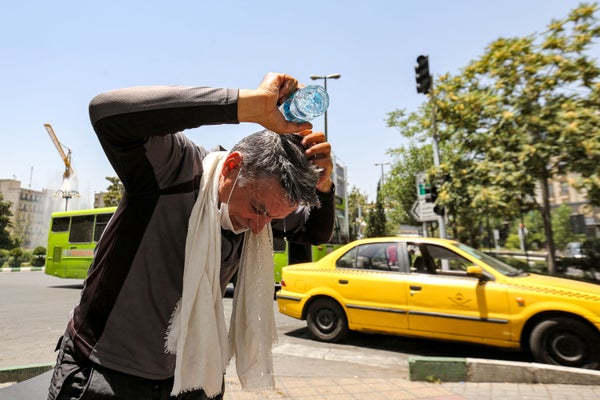Deadly heat is expanding across the hottest parts of the world. And with just another degree or so of global warming, large swaths of the planet — including every continent except Antarctica — will at least occasionally face conditions that test the limits of human survival.
That’s the warning from a new study out Friday in the journal Science Advances, on the growing dangers of life-threatening heat. And these lethal thresholds are approaching even faster than previous research has suggested, the study adds.
That’s because scientists typically have focused on the human body’s absolute upper limit when it comes to heat.
On supporting science journalism
If you're enjoying this article, consider supporting our award-winning journalism by subscribing. By purchasing a subscription you are helping to ensure the future of impactful stories about the discoveries and ideas shaping our world today.
It’s a threshold that assumes a healthy person already has taken every possible measure to adapt to the heat short of air conditioning or artificial cooling: They’re already accustomed to a hot climate, they’re drinking plenty of water, they’re seeking out shade, they’re wearing appropriate clothing, and they’re otherwise doing everything they can to survive.
There’s still a lethal heat limit, scientists have found, even with all these precautions in place.
In a widely cited paper published more than a decade ago, a pair of scientists from the University of New South Wales found that it lies around 35 degrees Celsius, or 95 degrees Fahrenheit, in wet bulb temperature — a metric that combines both heat and humidity. A 35 C wet bulb assumes 100 percent humidity, but the same lethal combination could be met with higher air temperatures and lower humidity levels.
Just a few hours of these conditions are unsurvivable even for the most well-adapted humans, the study found.
Since then, the 35 C threshold has been frequently used as a baseline in other papers predicting the future of lethal heat as the planet continues to warm.
But it’s not always the most realistic metric, said Carter Powis, a scientist at the University of Oxford and lead author of the new study.
Many people aren’t so well prepared when extreme heat strikes. They might not have ready access to shade or water or appropriate clothing, and they might not be accustomed to hot climates to begin with. In these situations, extended exposure to lower wet-bulb temperatures still can prove deadly.
The new study set out to investigate a lower limit for lethal heat, based on scientific studies of human physiology.
“The threshold we looked at in this paper I would think of as the lower bound,” Powis said. “These are the conditions that would be lethal assuming that you didn't do everything you could do to stay cool. You’re just an average healthy person taken off the street and exposed to this temperature.”
The lower limit also depends on different levels of temperature and humidity. A combination of 35 C and 75 percent humidity, for instance, could prove lethal in some circumstances after just six hours of exposure. The same goes for 40 C, or 104 F, and 50 percent humidity.
The researchers, including Powis and a team of scientists from Woodwell Climate Research Center in Massachusetts, then collected observations from thousands of weather stations across the world dating back to the 1950s. They found that lethal heat already occurs in some of the hottest regions of the globe.
Since 1970, more than 350 stations around the world have experienced at least one six- hour period of potentially deadly wet-bulb temperatures. And around 8 percent of all weather stations globally experience lethal heat about once a decade. The places at greatest risk include the Persian Gulf, northern India, parts of Indonesia and eastern China, the northern coast of Australia and parts of coastal Central America.
With just a little more warming, these extremes will spread to more places. The researchers used a statistical method to extrapolate their weather station findings for a hotter, future world. The planet already has warmed by more than 1 C. At 2 C, as many as a quarter of the world’s weather stations could experience deadly heat on at least a decadal basis.
The researchers found similar results when they used climate models, rather than a simple statistical method, to make future projections.
Lethal heat is expected to spread quickly across the hottest parts of the world. But it’s also likely to creep into more temperate regions of the globe. The researchers found that parts of Europe, as well as the East Coast and Midwest regions of the United States, would see rapid expansions of potentially deadly heat in a 2 C world.
“There’s essentially very little risk up to 1.5 degrees — and then between 1.5 and 2, suddenly this risk is everywhere,” Powis said.
This sudden, dramatic increase in potentially lethal heat may be most challenging for the midlatitudes and other regions of the world that aren’t already accustomed to extreme temperatures, Powis suggested.
These are places where “people don’t have air conditioning, and they don't have this cultural awareness of extreme heat and its danger because the climate has been traditionally temperate,” he said.
Mass casualties can result when extreme heat strikes in unprepared places. It’s happened in Europe several times over the last few decades, even during events that didn’t necessarily exceed the lethal threshold. Researchers estimate tens of thousands of people died during severe heat waves in 2003, 2010 and 2022.
That means policymakers should begin preparing today for sharp increases in future heat extremes, Powis said, rather than waiting for new lethal thresholds to take them by surprise.
“Everything will be fine and then suddenly it’s not — and when it’s not, it’s not going to be fine in a big way,” he said.
Reprinted from E&E News with permission from POLITICO, LLC. Copyright 2023. E&E News provides essential news for energy and environment professionals.
